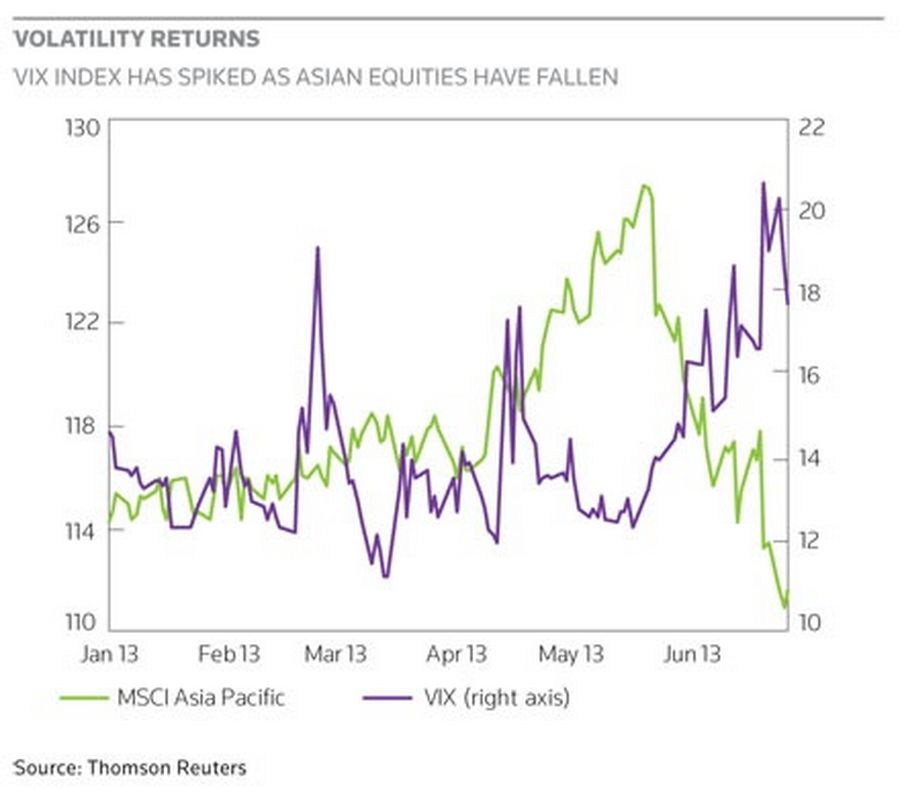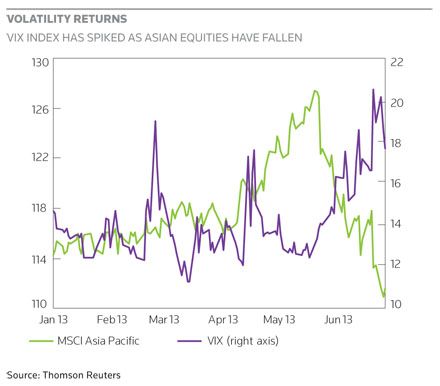Asian issuers may have missed the prime time for issuing convertibles, but the rising yield environment means CBs are more competitive than conventional bonds.

Source: Reuters
Two men surf on high waves at Hong Kong’s Shek O beach as typhoon Leo threatened to pound the territory with gale force winds.
Convertible bond issuance in Asia got off to a slow start in 2013, with issuance coming in fits and starts, but the recent rise in volatility and bond yields are making the asset class increasingly attractive for issuers compared with straight debt.
Bond redemptions in the Asia-Pacific region totalled US$9.3bn for the year to June 24, outpacing new issuance of US$5.9bn, according to Barclays research, leaving investors desperate for new paper. That is especially the case given that last year’s total CB issuance in Asia-Pacific was a dismal US$6.5bn, and lagged redemptions leading to a net US$2bn reduction in outstanding bonds.
On top of the short supply of new deals, two Asian issuers, Singapore’s CapitaLand and San Miguel Corp in the Philippines, exacerbated the shortage by tendering for old bonds as part of liability management exercises earlier this year.
“The market is hungry for paper currently; doability of deals is high at the moment,” said Aloke Gupte, JP Morgan’s head of equity-linked origination, Asia Pacific. “Unlike the bond market, convertibles have not seen massive issuance in the first half of the year. In line with trends seen in the rest of the world, we expect volumes to pick up as interest rates rise. We expect a pan-regional footprint for deals, with China having the largest volume as seen in previous years. South-East Asia is also expected to be very busy.”
China – the engine behind Asia’s equity-linked offshore issuance in recent years – has been notably quiet, although it did produce the biggest deal of the year just days before US Fed minutes flagging the future winding down of its Treasury purchasing programme sent yields rocketing. Hengan International Group, which produces non-discretionary consumer items like nappies, printed a HK$5.434bn (US$700m) zero-coupon convertible at a yield of 2.0% and premium of 35%. That was the highest premium for a new convertible in Asia ex-Australia for around two years, and came on the day Hengan’s stock hit a lifetime high, neatly illustrating the impressive terms achievable due to the scarcity of new issues.
Earlier in the year, China’s ENN Energy Holdings had raised US$500m from a zero-coupon deal in January, a couple of weeks after Shanghai Industrial Holdings priced a HK$3.9bn (US$503m) CB with a 1.0% yield-to-put/maturity – the lowest for a Chinese convertible bond since September 2010.
South-East Asia has only seen two issues so far this year, both from Singapore and both in the property sector. Suntec REIT printed a S$280m 1.4% five-year at a 20% premium in February, while CapitaLand issued a S$650m deal at the same time as it launched the tender for its old bonds. CapitaLand was able to take out S$432.5m of 3.125% bonds due 2018 but puttable in 2015, and replace them with seven-year paper with no investor put, paying a coupon and yield of just 1.85%. This was the longest-dated CB to print in Asia since September 2009, and the lowest yield ever for a real estate issuer in Asia.
Sweet spot
Convertibles typically pay around half the yield of a straight corporate bond, but this was not enough to sway many companies at the beginning of the year when investment grade and high-yield issuers alike could tap the bond market at will. However, by late June, Asia had gone three weeks without a new G3 bond issue, as corporate treasurers grappled with new pricing demands from investors.
That has put convertible bonds in a sweet spot, enabling issuers to lock in low interest costs in a rising interest rate environment, and making equity-linked terms perhaps their most attractive for issuers since 2007.
However, Asian markets tumbled again on June 24, extending an Asian credit sell-off to its sixth week, putting some convertible bond funds under pressure and prompting Barclays to write: “EMEA and APAC ex-Japan convertible returns have also been reset to approximately zero over the past week. Yet in APAC ex-Japan, convertible indices have outperformed both credit and equity indices YTD.”
The recent decline swung terms back in favour of investors and created value opportunities in the secondary market, but still leaves convertibles looking relatively attractive for issuers – even if they may wish they had capitalised on their share prices a month ago.
“The increase in rates, widening in spreads, and declines in share prices since the May 22 Fed minutes release make CB new issuance less attractive for most companies,” said Jim McDonnell, head of equity-linked origination for Asia Pacific at Credit Suisse. “However, valuations of CBs in the secondary market have held up relatively well compared to straight bonds, as the CB market has not been flooded with supply over the past year. We therefore expect the CB new issue market to pick up some of the supply that would have previously been brought via the straight debt market.”
Filling the gap
The sharp swings in share prices have proved to be a double-edged sword that could still boost prospects for equity-linked deals.
“The increased volatility we are seeing across the capital markets is a net positive for convertible bond issuance,” said Niraan De Silva, head of convertible bond origination for Asia at Bank of America Merrill Lynch. “With yields and credit spreads increasing, the relative cost of issuing a CB is becoming more attractive for issuers. In a low rate environment with robust credit markets, issuers incline towards bond financing. Volatility in equity prices is also helpful as it increases option value and maximizes savings relative to bonds.”
Most of the companies that have tapped the market so far this year have been high-quality names looking to capitalise on their share price performance.
“There is a lot of appetite for investment-grade names,” said Gaurav Maria, VP, equity-linked and derivatives, Asia, at JP Morgan. “Demand for these companies has been extremely strong and there is no change in that between then [before May 22] and now.”

However, there has been little issuance recently from the tier of issuers below that. Instead, sub-investment grade issuers in Asia went on a borrowing spree in the bond market, finding investors grateful for any pick-up on the razor-thin spreads available in the IG space. Now that investor demands for coupons on straight bonds may be beyond their means, this sets the stage for CBs to fill the gap.
“Apart from investment grade, the additional action is going to be in the BB-rated space, and frankly that’s what the market needs for volume and diversification,” said Nathan McMurtray, head of equity-linked origination for Asia at Deutsche Bank. “For instance, the China property sector was a huge part of the CB market in Asia historically, but there have been none coming to market recently.”
While CBs can still attract issuers with much lower yields than conventional corporate bonds, premiums are still far below their heyday.
“The market would have to change dramatically for conversion premiums above 40% to come back,” said McMurtray. “That has been the case for years in Asia and especially so now that outrights are as significant in order books as hedge funds.”
“For the right name, a higher premium deal of 30%-plus can still be achieved, but credit or equity hedge would need to be available,” said BofA Merrill’s De Silva.
Several issuers, Hengan among them, are understood to have set price targets on their share prices before being willing to launch their CBs. The consumer goods producer was said to have first looked to issue in the third quarter last year, but was willing to wait for its share price to appreciate. Other mainland Chinese issuers are also believed to be taking a long view with planned chunky deals, and the recent drop in share prices could delay them.
Convertible issuance at any price is still tough in some markets, though. Indian mid-caps went on an issuance spree in 2007, flooding the market with backloaded CBs, and many of them got into trouble when share prices fell significantly and they lacked the cash to repay on time. Repayments and refinancings last year achieved mixed success, and several companies are still delaying repaying their overdue CBs, with India’s tortuous, time-consuming legal process offering little recourse for investors. Some bankers and investors think there is little chance of any small-sized or medium-sized Indian company accessing the market unless there are options to hedge or protection for investors.
Mid-sized jeweler Gitanjali Gems tried to raise US$150m from a CB in late February this year, but did not find enough demand to cover the deal. Towards the end of discussions, investors were understood to have asked for the bond to be secured against Gitanjali’s US operations – and that was with a conversion price flat to the share price at launch.
Bankers expect only India’s larger cap stocks with big, liquid deals that can be hedged will be able to tap the market. Given the headaches that have come with many CB issues from the sub-continent, those kinds of companies could be forgiven for choosing other funding strategies, but if issuers from the rest of Asia show that attractive terms can be locked in, it could encourage India’s blue chips to return.
To see the digital version of this report, please click here.

